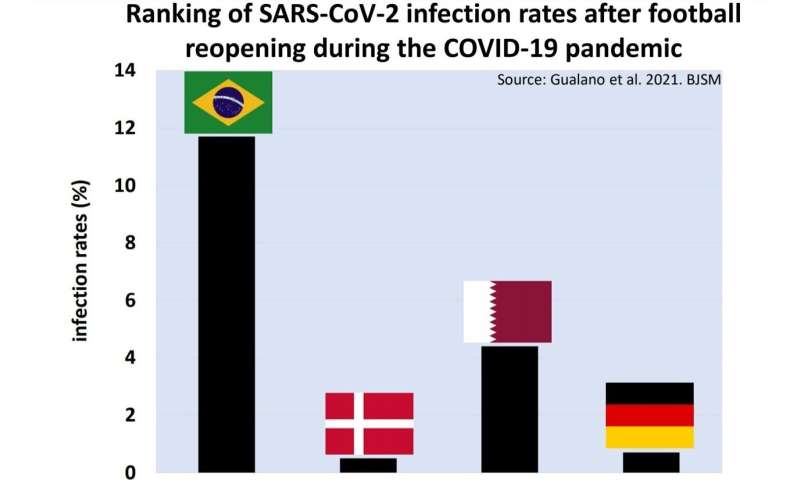The incidence of COVID-19 in a Brazilian regional soccer league is one of the highest


A study conducted at the University of São Paulo (USP) in Brazil shows that the incidence of infections by the novel coronavirus among professional soccer players in São Paulo state during the 2020 season was 11.7%, the same as among health workers in the front line of the response to the pandemic.
To arrive at this number, the researchers retrospectively analyzed almost 30,000 RT-PCR tests performed on swabs from 4,269 athletes during eight tournaments of the São Paulo State Soccer Federation (FPF), the league responsible for organizing official championships in the state—six for men (the São Paulo Cup, Under-23s, U-20s, and the three divisions of the São Paulo Championship) and two for women (the São Paulo Championship and U-17s). A total of 501 tests confirmed the presence of SARS-CoV-2. They also analyzed 2,231 tests on swabs from support staff (health workers, technical committees, directors, kitmen, etc.), and 161 (7%) were positive.
“It’s a much higher attack rate than has been seen in other countries. In Denmark, for example, only four out of 748 players tested positive [0.5%]. The Bundesliga [in Germany] found eight cases out of 1,702 players [0.6%]. Even in Qatar, where there’s a moderate risk of community transmission, the rate was far lower than ours: 24 out of 549 tested positive [4%]. Compared with the other reported rates, our players were infected between three and 24 times more,” Bruno Gualano, a professor at the University of São Paulo’s Medical School (FM-USP) and principal investigator for the study, told Agência FAPESP.
In an article published in the British Journal of Sports Medicine, the authors say the numbers are probably underestimated. The group had access to the database of the laboratory commissioned by FPF to test the athletes. However, players belonging to clubs that competed in national tournaments could choose to be tested by laboratories commissioned by the Brazilian Soccer Confederation (CBF), and these results were not included in the analysis.
In any event, the São Paulo data shows that the virus affected men and women equally among those tested. A comparison of the results for players and staff shows a high attack rate among players, but severe cases of COVID-19 were more frequent among staff, who are older on average and are not all in perfect health.
“This is a cause of concern,” Gualano said. “The few severe cases, one of which ended in death, were reported among members of staff. Although our data suggest players tend to manifest only mild symptoms or none at all, they can of course transmit the virus to others in the community. Most have a very active social life.”
Contact tracing has never been implemented in Brazil as a public health policy, he added, so it is not possible to measure the impact of the secondary infections caused by players in their households or social circles.

Risk factors
Owing to the social distancing measures implemented in the state of São Paulo in March 2020, soccer matches were temporarily suspended and resumed only on June 14. To minimize the risk of viral transmission, FPF’s Medical Committee created a protocol that calls for frequent testing of players and support staff, isolation of all infected individuals, contact tracing (within the sports community), and routine hygiene practices.
“Cases appeared whenever the protocol wasn’t followed,” said Moisés Cohen, who chairs the Medical Committee. “It’s a controlled environment where risks are monitored and minimized, including testing every two to three days. Players who leave [the isolation bubble] and return are tested every day. We also trace the contacts of individuals with positive test results and follow best practices in terms of protection, such as using PPE and hand hygiene,” he said.
According to Gualano, the risk of viral transmission during matches has proved low, but other factors impair the efficacy of the protocol, which he considers technically adequate. “It would work well if applied in Denmark or Germany,” he said. “It depends significantly on the common sense of the players, who are required to go straight home from the training center and maintain social distancing and non-pharmacological measures when resting. Here in Brazil, however, a sizable proportion don’t follow the rules and aren’t penalized at all. In addition, players and staff travel to and from fixtures a good deal. The smaller clubs travel by bus, eat at restaurants, and are probably more exposed than elite players. Our social inequality is also true of soccer.”
The study shows that some clubs were far more affected than others. One club reported 36 positives, with 31 occurring in a single month. Seven clubs had more than 20 confirmed cases and 19 had ten or more. For Cohen, all outbreaks are due to non-compliance with the protocol.
Gualano expressed strong concern over the resume of São Paulo Championship fixtures after suspension of all matches in São Paulo state on March 11, in response to the sharp rise in hospitalizations and deaths and the emergence of more aggressive viral variants. The suspension was lifted on April 10; nonetheless, matches during this period were taking place at Volta Redonda, a nearby city in Rio de Janeiro state.
Source: Read Full Article




